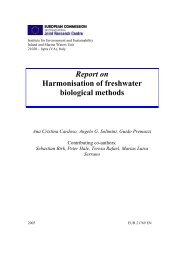Lakes and Watercourses
Lakes and Watercourses
Lakes and Watercourses
You also want an ePaper? Increase the reach of your titles
YUMPU automatically turns print PDFs into web optimized ePapers that Google loves.
winter/spring, i.e. ice-covered period, late summer/autumn) over three<br />
years are assessed for all lakes.<br />
Annual minimum values for watercourses are also assessed, although<br />
here assessment should be based on samples taken 12 times a year over<br />
three years. It may be necessary to monitor concentrations more<br />
frequently in small watercourses, particularly during the summer.<br />
TABLE 10.<br />
CURRENT CONDITIONS: oxygen concentration (mg O 2 /l)<br />
Class Description Annual minimum concentration<br />
1 Oxygen-rich ≥ 7<br />
2 Moderately oxygen-rich 5 – 7<br />
3 Moderately oxygen-deficient 3 – 5<br />
4 Oxygen-deficient 1 – 3<br />
5 No or almost no oxygen ≤ 1<br />
Note: The presence of hydrogen sulphide (H 2 S) is indicated by ††<br />
Samples from the deepest point in a stratified lake sometimes give a<br />
misleading picture of oxygen state if only a very small proportion of the<br />
total volume of the lake is deep water. To avoid this, a rule of thumb<br />
should be that readings taken from localities or sampling depths representing<br />
at least 10 per cent of the bottom area of the lake should be used<br />
to reflect the oxygen status of stratified lakes.<br />
TABLE 11.<br />
CURRENT CONDITIONS: organic matter<br />
(oxygen-consuming substances)<br />
Class Description Concentration as TOC or COD Mn (mg/l)<br />
1 Very low concentration ≤ 4<br />
2 Low concentration 4 – 8<br />
3 Moderately high concentration 8 – 12<br />
4 High concentration 12 – 16<br />
5 Very high concentration > 16<br />
30















![Accommodation booking form [PDF]](https://img.yumpu.com/39471785/1/184x260/accommodation-booking-form-pdf.jpg?quality=85)

